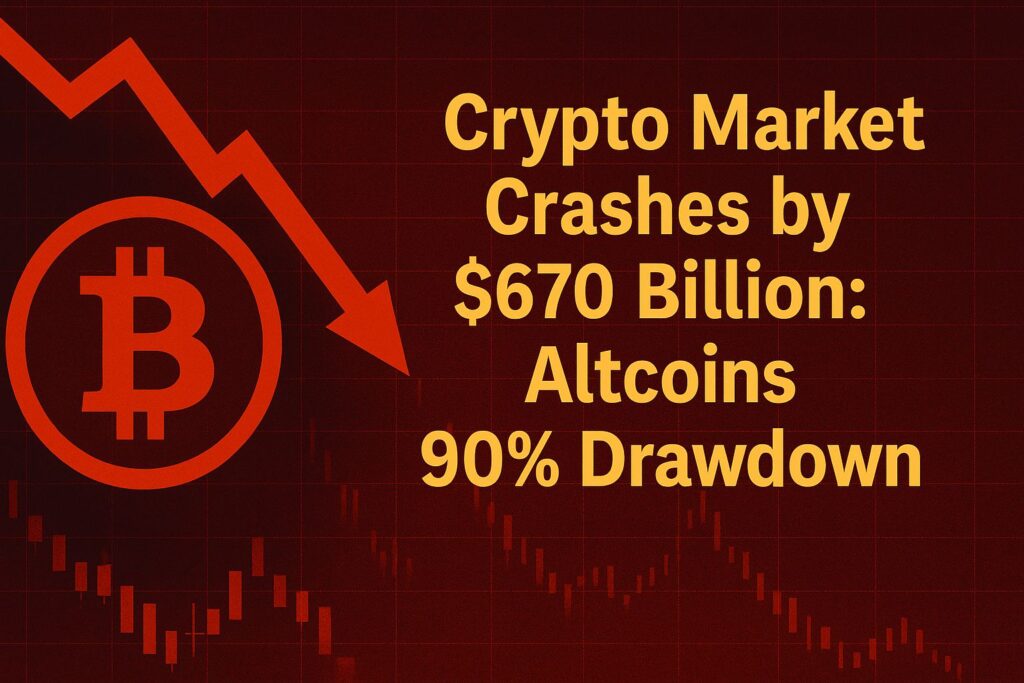The global crypto market just suffered one of the steepest declines in its history, wiping out over $670 billion in total market cap. The parabolic sell-off, triggered the crypto market crash by CEX auto liquidations and panic selling, has caused major upheaval in the digital asset ecosystem.
Cryptocurrencies experienced extreme drawdowns across the board, with altcoins seeing some of the most severe price action. Assets like SOL, ADA, LINK, DOGE, and various smaller cap DeFi and AI tokens plunged as much as 50-90% in a matter of minutes on major exchanges such as Binance. Meanwhile, Bitcoin and Ethereum recorded their sharpest drops in months but did not flash crash to previous support levels.
This unprecedented collapse was amplified by a significant macro event just hours before – the announcement from U.S. President Donald Trump of a 100% tariff on all Chinese goods, which spiked global trade tensions. The tariff decision, the most extreme escalation of the China-U.S. trade war to date, came as a major negative for investor sentiment across risk-on asset markets. Crypto, equities, and commodities sold-off hard in the immediate reaction.
Crypto Market Records More Than $19 Billion in Liquidations — Largest in History
In the last 24 hours, over 1.6 million traders across major centralized exchanges (CEXs) have been forcibly liquidated, wiping out over $19 billion in total leverage positions as per Coinglass data. This new liquidation record crushed the previous record established in May 2021 during the last Bitcoin flash crash, when all CEX liquidations amounted to around $8.6 billion.
“In the past 24 hours, 1,618,240 traders were liquidated, with a total liquidation amount of $19.13 billion. The actual totals are likely higher,” wrote Coinglass.
BTC price temporarily dipped to $105,000, while ETH flashed to as low as $2,380. However, both markets quickly recovered to the $112,000 and $2,600 levels, respectively. This suggests that the steep drop was likely exacerbated by algo-trading and instant liquidation engines, which led to severe slippage and cascading liquidation orders that distorted the order book.
Altcoins Plunge 50% to 90%: Cross-Margined Positions Are Automatically Liquidated
While Bitcoin and Ethereum both experienced heavy selling pressure and dumped to multi-month lows, the most significant damage came from altcoins. Every major altcoin on CoinMarketCap dropped sharply and fast, with popular tokens like SOL, ADA, LINK, DOGE, and many small cap DeFi and AI coins quickly plunging by 50% to 90% in a matter of minutes.
Veteran crypto trader and BitMEX co-founder Arthur Hayes was quick to identify a major catalyst for the crash. In a series of tweets, he cited CEX cross-margined collateral liquidations as the cause of the spike in forced sell-offs.
Per Hayes, there were a large number of CEX traders using a cross-margin strategy to trade using a shared collateral margin – essentially putting up a basket of coins as collateral to take on new positions. He argues that these cross-margined positions were automatically liquidated when the core assets held as collateral (ETH and BNB, in this case) plunged sharply in value.
“The problem is there are large number of CEX cross-margined positions, where traders deposit a basket of coins as collateral to open new trades. Those positions are automatically liquidated when ETH, BNB plunge,” he wrote.
The BitMEX co-founder also emphasized the snowball effect in such liquidation events. Once it begins, it feeds back into the market and drives price lower, even if the fundamentals are strong. Altcoins were hit hard in the ensuing liquidation cascade since most traders do not use cross-margin trading.
“It’s a vicious cycle, whereby the liquidations in a weaker project then trigger further liquidations in another,” Hayes added.
Binance, Coinbase, Kraken Experience Chaos as Order Books Freeze
A common complaint from traders during the peak of the market crash was that Binance order books were not working properly, orders were taking too long to fill, and price discovery was not happening in real-time. In reality, Binance was the first to go into an “unexpected outage” state as order books froze and trading slippage skyrocketed due to high volatility and the volume of liquidations.
According to Binance CRO, Yi He, the crypto exchange “experienced performance issues” on Wednesday due to a spike in liquidations and trading volumes, which “may have resulted in slower trade fills.”
Coinbase Pro, Kraken, and Robinhood also reported network and performance issues to customers, including inability to trade in real-time on mobile apps and other user experience problems.
Traders took to social media to express their dismay and confusion at not being able to place trades on Binance – including popular pseudonymous trader @Crypto_Cobra, who posted a clip of a party in Mexico where people were dancing to Juan Luis Guerra’s “Bachata Rosa.”
“We have pause please ensure your funds are safe and when you can submit a Loss Claim (which will be guaranteed) on affected trades. Thank you for your patience,” Binance’s Yi He wrote in response to the complaints on X.
Trump’s Tariff Announcement Serves as Macro Trigger for Crypto Sell-Off
While Bitcoin and altcoins dropped in response to soaring risk-off sentiment, the trade war escalation did not stop at digital assets. U.S. stocks, commodities, and major risk-on currencies such as the Euro, British Pound, and Australian Dollar all fell hard, if briefly, in the wake of Trump’s tariff hike.
This suggests that large, risk-on institutional traders were the first to take profits or de-risk completely by moving into cash, U.S. Treasuries, and other safe havens.
The fact that leveraged markets, such as CEX derivatives, cryptocurrencies, and stock index futures, all crashed within minutes of each other suggests strong correlation across multiple asset classes, with potentially negative flow going into cash and bonds.
In other words, Trump’s tariff increase is the global macro trigger that touched off a bloodbath in crypto, which may well get worse before it gets better. Past examples of geopolitical and macro driven risk-off events show that leveraged markets are likely to crash in tandem.
Opportunity to Buy the Dip? Crypto Analysts React
While many traders were panicking or down in the dumps, others were taking advantage of the sharp downside to buy the dip.
As with most parabolic crashes that are mainly the result of algorithmic liquidation cascades, several analysts believe that the crypto market is due for a strong reversal higher after such a deep overhang of extremely overleveraged and overextended traders have been flushed out, resetting the market structure.
Bitcoin and Ethereum to Remain ‘Safe Haven’
This includes BitMEX co-founder Arthur Hayes, who is betting big on Bitcoin and Ethereum staying resilient. This is due to their status as “safe haven” assets amid macro uncertainty, as well as the next round of Fed rate cuts in 2026 likely setting off a new massive BTC bull cycle.
“There’s a massive risk premium over the next few years baked into rates because of the next round of Fed rate cuts in ’26,” said Hayes.
Analysts Outline Key Signals to Accumulate Crypto
In addition to analyst commentary on Twitter and across social media, there are several key on-chain and exchange-level signals to watch to see if this is a good time to buy BTC and altcoins.
Possible buying triggers include but are not limited to the following indicators:
Stablecoin deposits to exchanges stagnating or dropping below their 7-day average.
Altcoin wicks forming higher daily lows, followed by a high volume spike
Whale accumulation picked up by on-chain analysis services, along with exchange outflows continuing
CEX stability issues partially resolved, order books no longer stalled, and no further exchange or platform outages that impact liquidity or orders being filled at a delayed execution price.
Crypto Market Sentiment: Fear-Greed Index Tanks to New Low
Crypto market sentiment is overwhelmingly negative, with the Crypto Fear & Greed Index falling to a new low in early Wednesday trading.
Although extreme fear is typically a sign that markets have oversold and could be due for a bounce higher, there is still risk of further downside in the near term due to high volatility, liquidity issues on exchanges, and other unknowns.
What to Do in Crypto Right Now: Risk Management Tips
Traders should employ standard risk management practices during such turbulent times. For investors seeking to enter the market, some key strategies include:
✅ Risk Management Checklist
Avoid using high leverage, which can lead to liquidations in a fast-moving market.
Use staggered limit orders to try and catch oversold altcoins at flash crash levels.
Dollar-cost average (DCA) into large cap projects like BTC, ETH, SOL
Track on-chain metrics, especially whale accumulation and exchange inflows/outflows
CEX and trading app stability updates, as platform outages can impact price action.
Final Thoughts: A Historic Crash That May Set the Stage for the Next Bull Run
Crypto market crashes have happened before and will likely happen again in future cycles. While the recent $670 billion wipeout may seem alarming, investors who practice sound risk management and see this as an opportunity to accumulate large-cap digital assets may turn this bloodbath into the next bull run.
As BitMEX co-founder Arthur Hayes said, it takes “steel nerves and spare capital” to turn such flash crashes into historic buying opportunities.


